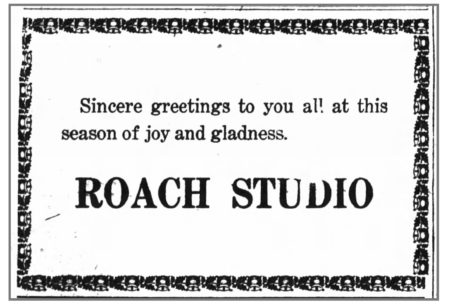Notes
Iva M. Roach’s career as a professional photographer involved working in a variety of places in the mid-west, including — but not limited to — Huntington, Indiana, the town where she sold her studio to Eva B. Strayer in 1922.
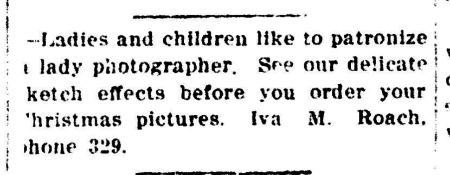
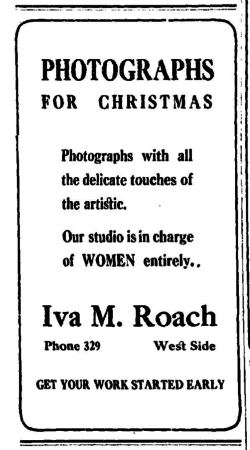

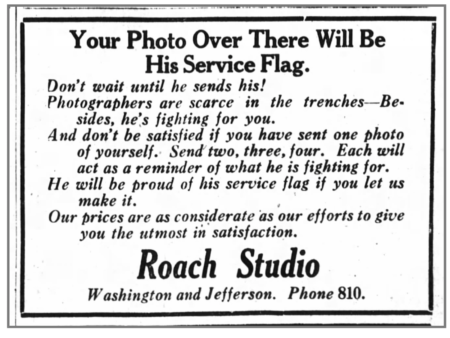


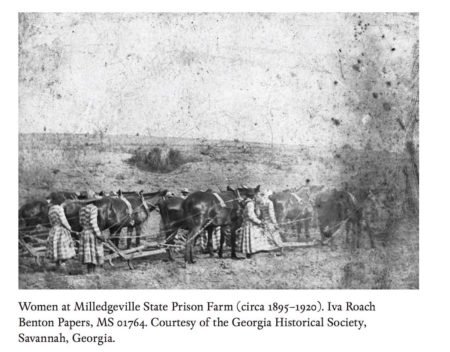
Lifeline
Recommended Links
- While I’ve yet to run across any books about Iva M. Roach. my favorite place to start to read more about early women artisan photographers in general would be these books:
- Online research sites used to research Iva Roach. [Note that aside from the material mentioned in this episode, I’ve found no other trace of the mystery man name James E. Collopy.]
- Family Search website has U.S. Federal Census and more; free account required – Visit
- Ancestry.com (census records, city directories, and more; paid account required – Visit
- Geneologybank.com has a selection of digitized newspapers from the United States; paid account required – Visit
- Newspapers.com has a selection of digitized newspapers from the United States; paid account required – Visit
- Newspaperarchives.com has a selection of digitized newspapers from the United States; paid account required – Visit
- Online pdf of No Mercy Here book by Sarah Haley – View
Transcript
You’re listening to Photographs, Pistols, and Parasols.
Support for this project is provided by listeners like you. Visit my website at p3photographers “dot” net for ideas on how you, too, can become a supporter of the project.
Welcome to Photographs, Pistols & Parasols, the podcast where we celebrate early women artisan photographers.
I’m your host, Lee McIntyre.
Today we have a successful photographer, with a tale that involves larceny and deceit. What are the chances for a happy ending?
Welcome to the story of photographer Iva M. Roach.
For more information about any of the women discussed in today’s episode, visit my website at p3photographers.net. That’s letter “p”, number “3”, photographers “dot” net.
*****
Iva Roach was a photographer that I ran first across when I saw a notice in 1922 in the Huntington newspaper that said that the Roach studio, run by Iva Roach, was being sold to Miss Eva B. Strayer.
As it turned out, Iva Roach had only been in Huntington for 4 or 5 years.
But she had worked as a photographer before she came to Huntington, and that’s what I want to tell you about today.
Iva Marie Roach was born in Indiana in 1868.
By 1880 we find her living in Buena Vista, Indiana, with her parents, Joel T. Roach and Mary Jane Niedhammer Roach, along with her siblings, including 2 brothers and a younger sister named Sarah Myrtle (who usually went by the name Myrtle).
Iva was a photographer in a variety of places in the Midwest.
How, when, and exactly where she started as a photographer is still a bit of a mystery to me.
But by 1890, at the age of only 22, she’s already running her own studio in Cicero, Indiana.
Now, according to the press release notice that’s in the newspaper to announce the opening of her new studio in Bloomington, Indiana in November of 1915, Iva is bringing years of experience as a photographer to Bloomington, having previously worked in Chattanooga, Memphis, Cincinnati, and Indianapolis, as well as in Cicero.
That notice also mentions that she’s been the president of the ladies organization of the Indiana Photographers’ Association, and it says that she even studied art at the John Herron Art Institute in Indianapolis.
Now Iva’s in Bloomington right before she moves to Huntington, where she’s settled by 1918.
And once she’s in Huntington in the 1918, there are a bunch of ads in the newspaper for the new Roach studio.
And there’s one that’s really eye catching. I’ll put it in the episode notes, but let me just read you a little bit of it.
It says “Your Photo Over There will be His Service Flag! Don’t wait until he sends his — photographers are scarce in the trenches! Besides, he’s fighting for you! Don’t be satisfied if you have sent one of yourself — send two or three or four. Each will act as a reminder of what he is fighting for.”
As I said it’s a really eye catching ad, quite big and boxed.
Iva is not the only photographer I’ve seen advertising to have you get your photo taken to send to your soldier overseas, but her ad is certainly the most interesting in terms of the arguments she offers in that ad.
Anyway, I’ll post a copy of Iva’s ad on the p3photographers.net website.
****
But the most intriguing episode that I’ve uncovered from Iva’s life comes before 1915, a little earlier in that same decade.
Let me first set the stage:
We’re in Huntingtion, Indiana in 1911.
It’s August , and it’s kind of dry and dusty, and Dr. Smith, the local doctor in town, is driving his car slowly following a water wagon called a “Sprinkler”, which is spreading water on the road to try to keep the dust down.
Now the doctor was driving slowly, but as he’s following that Sprinkler, his car is run into by a heavy farm wagon that makes a huge dent that really destroys the passenger-side door of his car.
The driver of the farm wagon takes off, but the doctor follows him.
Then, when he catches up to the driver, the doctor offers to settle because he just wants the money to get his car fixed.
According to the newspaper article that details this incident, the doctor and the driver of the farm wagon exchange what’s called “a few hot words” before the driver takes off again.
So the doctor goes to the police.
The police go and find the driver.
And what’s interesting is that the newspaper article describes the man as reluctant to even give his name.
But he finally — reluctantly — says that he is James Collopy, staying with Ernest Stults, who owns a farm at the edge of town.
Now this incident and the aftermath — when the doctor is trying to get witnesses to come forward so that he can have the man be forced to pay for his car — well, that’s all in the news in August of 1911.
But it’s dropped from the newspapers after that, so I don’t know what exactly [ultimately] happened.
The main reason I bring this up is because I wanted to introduce you to this James Collopy.
Now, he’s staying on the farm of Ernest Stults in Huntington.
In 1910, Ernest Stults is living on that farm with his wife, Myrtle, their six children, and his mother-in-law, Mary Jane Roach.
Mary Jane Roach, you might recall, is Iva Roach’s mother.
So that all means that Ernest Stults is actually Iva Roach’s brother-in-law.
There are notices in the newspapers over the years in the early 1900s when Iva Roach is visiting her sister, Mrs. Stults, and her family on that farm in Huntington.
So Iva was definitely going back and forth to Huntington even before she ever lived and worked there.
But it’s not clear if she’s there in August 1911 when this incident happens, when James Collopy is staying with the Stults family.
Now even though James Collopy wouldn’t give his details to the police officer in August 1911, I can share some details with you from his 1912 marriage license application.
This marriage license application is filed in February 1912.
James Collopy is listed as being born in Kentucky in 1883, and it says that he’s currently living in South Bend [Indiana], working as a photographer.
His bride on that marriage license application is none other than our photographer today, Iva Marie Roach.
She also is listed as being a photographer living in South Bend.
So, sometime before 1912 apparently, James Collopy and Iva Roach met and started working together as photographers in South Bend.
After they get married they continue to work as photographers in South Bend, but by the end of 1912, they’ve bought and are running a studio in Warsaw, Indiana.
But then, in January of 1913, there’s a curious set of articles from the newspaper, and I just want to read you a small selection of them.
Our first one is Dateline: Warsaw, Indiana, January 14, 1913.
Headline: “Warsaw Photographer Arrested on Larceny Charge”
It reads,
James E. Collopy, a photographer of this city, was arrested in Chicago and returned to Warsaw Tuesday morning in the custody of the sheriff and the marshall The charge against Collopy, that of larceny, was preferred by his wife, Iva M. Collopy, who claims that he took all the money from the safe at their studio and also drew $350 which she had deposited in a local bank, and then left for Chicago. Unable to furnish bond, which was fixed at $1,000, Mr. Collopy will remain in jail until his case is tried in the circuit court. He is extremely reticent regarding the affair and has made no statement.
Another article from that same time, but in a different paper, notes that it was Iva who quickly discovered the missing money and went immediately to the sheriff.
And so the sheriff was able to set out right away trying to track down James Collopy, and actually catches up with him as James Collopy is stepping off the train in Chicago.
Next article: from the Fort Wayne Journal Gazette
Dateline: Warsaw, Indiana, January 18, 1913.
Headline: Warsaw Photographer Still Confined in County Jail
James E. Collopy, who was arrested in Chicago and brought to Warsaw several days ago, is still confined in the county jail. Mr. Collpy was arrested on charges preferred by his wife, who claimed that he took $350 belonging to her when he departed Warsaw. By the order of Mr. Collopy, the money has been returned to his wife. The authorities are conducting an investigation regarding the photographer’s past life, but, owing to the extreme reticence of the prisoner, have been able to find out nothing of importance. It is believed that Collopy is an assumed name and that there may be a past record not favorable to the prisoner. The date for hearing the case has not been set.
Alright, so, there are other articles that basically rehash all the details of the case over the next week or so.
But then we get to January 23rd and this unexpected headline, which reads. “Asks for Dismissal of Collopy Case”.
The article goes on to say,
Prosecutor Anglin has petitioned the court to dismiss the case against James Collopy who was arrested in Chicago several days ago on a charge of taking his wife’s money the petition was made at the request of a number of reliable witnesses.
A couple of days later, there’s an article — just a little notice — that appears that says that indeed all the charges have been dropped, the case dismissed, and James Collopy and his wife, Iva Collopy, have reconciled.
Interesting, eh? I mean, this was just as though one month wonder there in Warsaw, Indiana, because throughout the rest of 1913, and even throughout 1914, there’s no further mention of any domestic problems or anything about that photography studio run by the Collopys in Warsaw, Indiana.
But Iva continued to be a photographer during this period. It’s actually during this period in 1914 that Iva, under her married name Mrs. J.E. Collopy, becomes the president of the Indiana Photographer’s Association Women’s Auxiliary Committee.
There’s an article about that in the paper in Indiana in 1914, but there’s no mention of the Collopy studio there in Warsaw.
But then, in 1915, on July 7th, there this little notice that appears in the Fort Wayne Journal-Gazette that is not entirely unexpected:
Headline: “Warsaw Woman Files Suit for Divorce
Indeed, Iva Collopy has filed for divorce from James Collopy, charging him with desertion.
Apparently, he skipped town a while back [before July 1915]; there’s no trace of him, she’s no idea where he is, and she just wants a divorce.
After filing for divorce in Warsaw, Iva actually moves to Huntington.
I’m guessing, but I can’t prove, that she’s staying at that point with her sister there, on the Stults farm.
In September of 1915, Iva is granted the divorce.
And because James Collopy doesn’t actually appear, he’s represented in absentia by the prosecutor.
I wonder if that helps Iva make her case, so that she is able not only to get a divorce, but also gets the right to revert back to her maiden name of “Roach”.
Now, on the one hand, I felt really sorry for Iva when I read this, because, boy, that had to have been terrible.
She’s betrayed by her husband — he steals all her money!
But she does get the money back at least, and she’s really resourceful.
I mean, when she discovers the money’s gone, does she sit around and cry?
Nope, she goes immediately to the sheriff and gets the sheriff on her husband’s trail so that they can get him and the money back!
We’ll probably never really know what happened after Collopy gets released from jail in 1913.
And we will probably never really know who those “reliable” witnesses were who came forward to get that case dropped.
You’ve go to wonder what was going on there.
But the main thing that I take away from the story is that Iva Roach was incredibly resilient.
I mean, she bounces back: she gets her name back and then, once the divorce is granted, she moves to Bloomington and she takes out the big ad and the big press release notice, that she’s opening this new studio.
She’s starting again!
This is great! I love to find stories like that.
After she was in Bloomington … she finds success as a photographer … once again in Bloomington, and then, of course, subsequently in Huntington.
And then in 1922 we find that she’s finally lucky in love as well.
In June of 1922, Iva Roach marries another photographer named Fred Benton.
The Bentons move to Oakland City, Indiana, where they run a photography studio before retiring.
They are together for 40 years until Fred dies in 1962.
Iva dies the next year, 1963, at the age of 96.
Clearly, when Iva left Huntington in 1922, she left not only to form a successful business partnership but also have a very happy marriage with the photographer Fred Benton.
So that’s the story of Iva Roach, which is ultimately the tale of a resilient, successful woman entrepreneur and photographer, whose life story has a happy ending.
Now in the episode notes for today I’ll share a lot of the ads that Iva Roach took out in various newspapers.
I think you’ll enjoy seeing these ads because they’re very interesting — very colorful in terms of how she’s portraying herself, her abilities, and her specialties.
As always, the episode notes will be available on my website at p3photographers “dot” net.
Also, remember you can always drop me an email at podcasts “at” p3photographers “dot” net, or follow me on Facebook at facebook.com/p3photographers.
In the next episode we’re going to be moving on from Huntington.
Before we go, I just want to thank once again all the folks in Huntington, Indiana who were so helpful in uncovering information about these wonderful women photographers that I’ve talked about in the last couple of episodes.
Next time, we’re going to travel to Kansas and discover just how many women photographers there could be in one little town.
I guarantee it’s going to be a lot more than you might think…
So, until then, I’m Lee, and this is Photographs, Pistols & Parasols.


